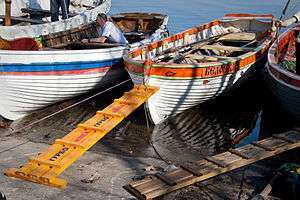Yal (boat)


Yal (from Dutch: jol to Russian: ял) – Russian and Soviet Naval transom stern light weight rowing-boat with one removable mast and set with the sail. A small yal is sometimes called a yalik, the diminutive form of yal.
Yals were used as life-boats, mooring boats, boat for kedge operations, supply boats, boat for works alongside the ship (painting, e.t.c.), boat for communication with the shore and for personnel transportation, small fishing boats since the 19th century.
Yals are popular for sport and tourism purposes also.
The six-oar, four-oar and two-oar yals have one mast used to support two quadlilateral standing split-lug sails. Wooden yals are constructed of oak keels, stem and stern posts, ash thwarts and gratings, and pine or laminated glued spruce strakes.
Types of yals according to the materials used for the manufacture of distinguished, the last digit means the maximum quantity of oars:
- Wooden - ЯЛ-6, ЯЛ-4, ЯЛ-2,
- Veneer - ЯЛШ-6, ЯЛШ-4, ЯЛШ-2,
- Plastic - ЯЛП-6,
- Alloy - ЯЛА-6.
Two-oar yal
Length - 3.55 m
Width - 1.25 m
The two-oars yal is rigged with a split-lug sail and is able to carry up to three people for short distances in sea conditions up to 2 points on the Beaufort scale.
Four-oar yal
Length - 5.26 m
Width - 1.61 m
This yal is able to carry up to eight people.
The four-oared yal is rigged with a split-lug sail on a single mast, and sometimes can be supplied with outboard motor. Often referred to as a "gig" (gichka in Russian).Able to transport light goods or people.
Six-oar yal
.jpg)
Length - 6.11 m
Width - 1.85 m
Maximum persons on board if winds not more than 5 points as per Beaufort scale, in areas closed from the waves:
- Under oars - 13 persons;
- Under sail - 8 persons in case weather not more than 5-6 as per Boufort scale.
Yal-6 or six-oar yal - seaworthy boat is rigged with a split-lug sail on a single mast. Originally the yal-6 was made of wood, but since the late 1990s more commonly made of plastic. Propelled with oars, sails or outboard motor.
This yal has the following parameters: length - 6,11 m, width - 1,85 m, height from keel to gunwale (amidships) - 0.91 m, weight 600–650 kg (wooden), 450–500 kg (plastic).[1]
Jalbut – is it kind of dhow or yal?
The boats pictured below are sometimes referred to as a dhow (as a kind of dhow) due to its location in the Indian Ocean dhow area. Some writers have mentioned that the jalbut was used first in the Persian Gulf and later it expanded to other areas. It is possible, as the number of crew and hull construction conform to the 19th century naval yawl-boat, that yals came in South-East Africa from the Russian Imperial Navy ships were running around the Africa or Soviet Navy ships were based in regions of the Indian Ocean and the yal influenced local jalbut or dhow design. Yals in Kenya can be supplied with one balanced mast. Note that the Russian yal and jalbut have a more similar style of dhow bow and stern also. The dhow bow has typically a much sharper bow configuration than that of its Kenyan counterparts.
 An yal fitted with a zarug (zaruq) sail's set in the Indian Ocean near Zanzibar.
An yal fitted with a zarug (zaruq) sail's set in the Indian Ocean near Zanzibar. Kenyan coast dhows and yals, kijahazi? Unknown date, possibly 1960's
Kenyan coast dhows and yals, kijahazi? Unknown date, possibly 1960's Yals under sails in Inhambane, Mozambique.
Yals under sails in Inhambane, Mozambique.
Jalbut or jalibut or jelbut or modern dhow is increased size (mostly more longer than yal) of yal-6. Due to transom stern jalbut is mostly motor-ship that often has deck and not so often use oars and sail or sails. Bow and transom stern of jalbut are the same type about as yal. Like Jalbut (Jalibut) could receive name from jal when:
- Russian Tsar Navy armada passed from Europe side of RUssia around the Africa to the Russian Far East in 1904 due to increase Russian fleet on the Russian-Japanese War theatre.
- as during 1950–1970 years Soviet Union military and merchant vessels equped with yals often visited countries of South-East Africa and Persian gulf in 1950s-1970s, mostly when the Suez Canal was closed.
You can see photo with jalbut here http://www.al-bab.com/bys/articles/taylorpix2.htm# FIGURE 6
Books
- "Военно-морской словарь" ("Original Naval Dictionary"), page 196, Authors - Chief editorial office of the leaders of the USSR and the Russian Navy, Commander of the Navy Admiral Tchernavin V.N., ISBN 5-203-00174-X, total pages 511, Year 1989, Publisher - Воениздат, Moscow.
- "Учись морскому делу" ("Learn seamanship"), page 141, Authors - Bagryantsev B.I., Rechetov P.I., Total pages 175, Year 1986, 2nd supplemented edition, Publisher - ДОСААФ, Moscow.
See also
References
- ↑ «Шестивесельный ял» — «Словарь по естественным наукам. Глоссарий.ру» в Яндекс Словарях (Dictionary of the natural sciences. Glossariy in Yandex.ru dictionaries).
External links
| Wikimedia Commons has media related to Yal. |
- «Ял» — «Словарь по естественным наукам. Глоссарий.ру» в Яндекс. Словарях ("Yal" - "Dictionary of the natural sciences. Glossariy in Yandex.ru dictionaries).